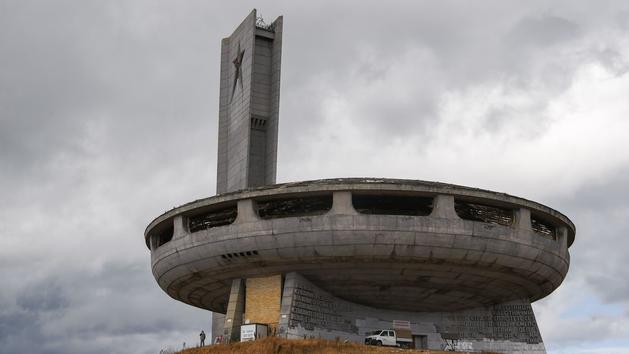In the heart of Bulgaria, an abandoned communist monument is experiencing a new lease of life with the mobilization of experts working to save its ruined mosaics.
“
It's a race against time.
We must act quickly because there will be no more mosaics if we wait for a decision
”from the authorities on its future, Bulgarian architect Dora Ivanova told AFP, who fell in love with this building in Bouzloudja. .
The mosaics in the glory of communism which are being restored.
NIKOLAY DOYCHINOV / AFP
Erected in 1981 at an altitude of 1,400 meters on the Balkan range, this circular concrete and steel enclosure, in a brutalist style, an architectural style that enjoyed great popularity from the 1950s, stands next to two 70-meter high pillars.
At its peak, the red star, now decrepit, was once visible on a clear day as far as Romania and Greece.
The city at the foot of Mount Bouzloudja is called Kazanlak.
NIKOLAY DOYCHINOV / AFP
Stripped over time of its bronze and copper ornaments, its roof pierced with gaping holes, the monument, described as an “
architectural feat
”, houses monumental mosaic panels to the glory of Communism: scenes of “
anti-fascist
”
battles
, the Red Army or even women in socialist society.
On the ceiling, the sickle and the hammer are still enthroned, symbols of the unity between workers and peasants, while the famous Marxist slogan is displayed on the facade: "
Workers of all countries, unite!"
".
On the roof of the dome, we can still see the sickle and the hammer.
NIKOLAY DOYCHINOV / AFP
Originally, the mosaics extended over nearly 1,000 square meters, mixing Byzantine techniques and new materials and processes.
A third has disappeared, victim of bad weather or criminals.
A clumsy graffiti of ex-Communist dictator Todor Zhivkov, sacked in 1989, replaced the mosaic with his portrait.
“
The aim is not to restore the monument to its former splendor
,” assures Professor Thomas Danzl of the Technical University of Munich.
The team, anyway, cannot afford it.
The operation was financed by a donation of 185,000 dollars (158,000 euros) from the American Getty Foundation, which will be just enough to preserve some of the mosaics.
Experts preserve a kind of memory by preserving these mosaics.
NIKOLAY DOYCHINOV / AFP
“
We will keep (the monument) as we find it at this time.
We also keep the graffiti as a sign of the times, of the last 30 years,
”explains Thomas Danzl, specialist in the legacy of the former GDR.
Eighteen German, Greek, Bulgarian and Swiss experts and students devoted themselves to the meticulous conservation work of the mosaics, carried out in particular using syringes.
"
We treat critical areas using a minimum of invasive materials
" to maintain the mosaics until the authorities decide, explains the technical head of the operation, Nikifor Haralampiev, of the Academy of Fine Arts in Sofia.
Special materials are used to preserve the mosaics.
NIKOLAY DOYCHINOV / AFP
Resistant to the debate on communist monuments, assimilated in Bulgaria to a hated regime, the government is slow to grant the Bouzloudja building a status which would allow it to raise the funds necessary for its restoration.
“
It is society that must decide on the functionality of the monument.
There have always been voices for and against, so a debate is necessary,
”says Regional Council President Gergana Mihova only.
Behind the props, Marx, Engels and Lenin.
NIKOLAY DOYCHINOV / AFP
The building, at the time an instrument of propaganda, then popular with lovers of unusual places, could become a place for educational and tourist purposes where the history of Bulgaria through the centuries would be traced, imagines Dora Ivanova.

